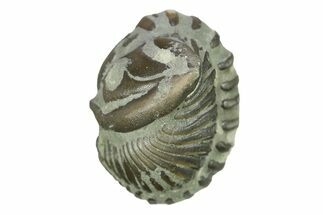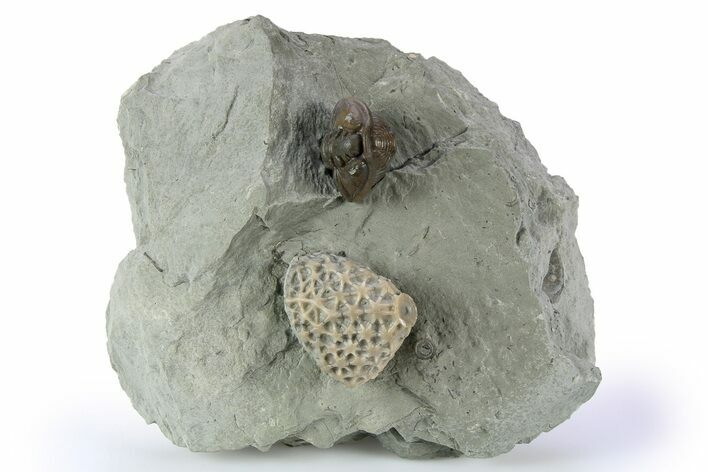This Specimen has been sold.
Enrolled Flexicalymene With Crinoid Calyx - Mt. Orab, Ohio
This is a 4" wide piece of shale that contains an enrolled Flexicalymene retrorsa trilobite fossil and a crinoid calyx (Pycnocrinus dyeri), collected from the famous trilobite beds at Mt. Orab, Ohio. The fossils were cleaned using air abrasives under microscope. They likely weren't found naturally associated since the trilobite has been mounted to the rock.
It comes with an acrylic display stand.
It comes with an acrylic display stand.
Flexicalymene is a genus of trilobites of the order Phacopida, suborder Calymenina. These ancient arthropods are an index fossil of the Ordovician, between 488-443 million years ago. The graceful articulation, especially of the thorax segments, demonstrates that this distant precursor of insects is deserving of its delightful name.
Flexicalymene is often found enrolled, seemingly to protect its softer underside from threats on a sea floor teeming with ancient life and increasingly complex predators. Sealing itself inside the hard carapace may be a protective maneuver, or it may simply be the pose of death.
Two species of Flexicalymene are found in the Richmond Formation of Ohio, but in different sub-units. Flexicalymene meeki has small genal spines and is the more common of the two, often coming from Mt Orab, Ohio. These spines are absent in the other species, F. retrorsa. The F. retrorsa cephalon is more rounded, while the F. meeki cephalon is pronounced. They were also denizens at different locales. Calymene, meaning “beautiful crescent”, should not be confused with Flexicalymene: it is a separate genus.
Flexicalymene meeki has been studied for its abundant perforations. The perforations have been interpreted as the loci of sensory hairs: these loci occur in many sizes, and are an interesting feature of exoskeleton microfeatures. They are concentrated on areas most likely to contact other objects in the environment.
Flexicalymene is often found enrolled, seemingly to protect its softer underside from threats on a sea floor teeming with ancient life and increasingly complex predators. Sealing itself inside the hard carapace may be a protective maneuver, or it may simply be the pose of death.
Two species of Flexicalymene are found in the Richmond Formation of Ohio, but in different sub-units. Flexicalymene meeki has small genal spines and is the more common of the two, often coming from Mt Orab, Ohio. These spines are absent in the other species, F. retrorsa. The F. retrorsa cephalon is more rounded, while the F. meeki cephalon is pronounced. They were also denizens at different locales. Calymene, meaning “beautiful crescent”, should not be confused with Flexicalymene: it is a separate genus.
Flexicalymene meeki has been studied for its abundant perforations. The perforations have been interpreted as the loci of sensory hairs: these loci occur in many sizes, and are an interesting feature of exoskeleton microfeatures. They are concentrated on areas most likely to contact other objects in the environment.
Crinoids, sometimes commonly referred to as sea lilies, are animals, not plants. They are echinoderms related to starfish, sea urchins, and brittle stars. Many crinoid traits are like other members of their phylum; such traits include tube feet, radial symmetry, a water vascular system, and appendages in multiples of five (pentameral). They first appeared in the Ordovician (488 million years ago) and some species are still alive today.
SPECIES
Flexicalymene retrorsa & Pycnocrinus dyeri
AGE
LOCATION
Mt. Orab, Ohio
FORMATION
Arnheim Formation
SIZE
Trilobite: .82" wide, Entire Specimen: 4 x 3.5"
CATEGORY
SUB CATEGORY
ITEM
#255761
We guarantee the authenticity of all of our
specimens. Read more about our
Authenticity Guarantee.
specimens. Read more about our
Authenticity Guarantee.
 Reviews
Reviews















